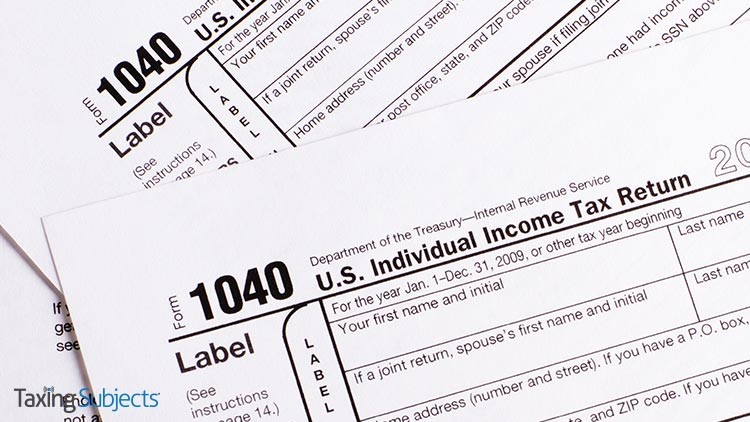by | Apr 30, 2021 | Tax Tips and News
This tax season, like so many before, a lot of filers could use a little extra time to get the job done. And while it’s true that anyone can request an extension of time to file beyond this year’s May 17 deadline, some taxpayers don’t even have to ask in order to have more time to file.
According to the IRS, over 16 million filers will get an extension “by filing a form or making an electronic payment.” But at least three groups won’t have to do anything to receive additional time to file.
Here’s a breakdown.
Winter Storm Disaster Victims
Old Man Winter did his worst to residents of Texas, Louisiana and Oklahoma recently. Because of near- and sub-zero temperatures, snowfall and other record conditions, portions of the three states were declared federal disaster areas.
Residents of any county within a federally declared disaster area in any one of the three states is entitled automatically to an extension of time to file, putting their tax returns due on June 15. This date applies to filing returns and paying any tax due.
For disaster victims in an area qualified for FEMA’s Individual Assistance program, there’s no need to contact the IRS to qualify. All the applicable extensions and other disaster-related relief are applied, based on the taxpayer’s address of record on file with the IRS.
This relief includes more time for making contributions to IRAs and other retirement plans for the 2020 tax year, and making estimated tax payments for 2021.
Relief is also available to those living outside the disaster area in certain circumstances.
For example, these taxpayers might live outside the disaster area but have a business within the disaster area, have tax records within the disaster area or are assisting in disaster relief efforts.
Check out the Around the Nation page on IRS.gov for details on all available relief.
Taxpayers in a Combat Zone
The Internal Revenue Service gives soldiers and eligible support personnel who are serving in a combat zone at least 180 days after they leave the combat zone to file tax returns and pay any tax due. Publication 3, Armed Forces’ Tax Guide, has a complete list of designated combat zone locations.
Military and support taxpayers in combat zones also have more time for other tax-related functions, such as making contributions to an IRA. Since various circumstances can affect what extensions are available to an individual, refer to Publication 3 for guidance.
Taxpayers Living Outside the U.S.
U.S. citizens and resident aliens living and working outside the U.S. and Puerto Rico also get a break on the filing deadline. They have until June 15 to file their 2020 returns and pay any tax due.
The June 15 deadline also applies to U.S. military forces on duty outside the U.S. and Puerto Rico, but who are not serving in a combat zone. The IRS recommends taxpayers include a statement with their tax return explaining which situation applies to them.
Taxpayers abroad should note that while they get an extension of time to file and pay, there’s a penalty for late payments. Interest will be charged at 3 percent per year, compounded daily, to payments received after the May 17 deadline.
Publication 54, Tax Guide for U.S. Citizens and Resident Aliens Abroad, has more information on special rules for U.S. taxpayers living outside the country.
Other Taxpayers
The usual method for obtaining an automatic extension still applies for taxpayers who aren’t in these three special groups is to simply submit a request for an automatic extension to extend a taxpayer’s filing deadline until Oct. 15. (Payment of any tax due, of course, is still due by May 17.)
Other than filing Form 4868 to request an extension, taxpayers can pay their tax due electronically to get an extension to file. Online payment sites like Direct Pay or the Electronic Federal Tax Payment System (EFTPS) can be used, as well as debit or credit cards.
Check out all the payment options at IRS.gov/payments.
Source: IR-2021-96
– Story provided by TaxingSubjects.com
by | Apr 29, 2021 | Tax Tips and News
The Internal Revenue Service has kept taxpayers’ mailboxes busy for months now, sending out notices to taxpayers about the various Economic Impact Payments that have been issued.
The agency was required to mail a notice to the last known address of each Economic Impact Payment (EIP) recipient every time a new EIP was issued. So, it’s a fair bet to say many tax professionals have had more than one question about what these notices mean to the average taxpayer and what to do with them, so we thought a little explanation was in order.
What is in the EIP notices?
Every time there’s a new Economic Impact Payment, the IRS has to send out an accompanying notice, telling potential recipients about the amount of the payment, how it was paid out, and how to report a payment that wasn’t received.
Some people may get more than one notice for the same EIP. Most, hopefully, will simply hang onto the notice until it’s time to file their return. Here’s a look at each notice that taxpayers could have received:
Notice 1444, Your Economic Impact Payment. This was the very first notice for an EIP, sent out just 15 days after the first payment was issued in 2020. If the IRS corrected the amount of the first payment, or sent out more than one payment to a recipient, they would have gotten another notice.
Those who got a Notice 1444 but not the first EIP should check the frequently asked questions on the IRS website, looking for instructions on what to do if the first payment is lost, stolen, destroyed or has not been received. Recipients should keep this letter with their records for the 2020 tax year.
Notice 1444-A, You May Need to Act to Claim Your Payment. This letter was sent out in 2020, aimed at individuals who usually aren’t required to file a federal income tax return but could have been qualified to get the first Economic Impact Payment.
Those who didn’t get the first and second EIPs—or got less than the full amounts—may still be able to claim the 2020 Recovery Rebate Credit. However, they’ll have to file a 2020 return to get the credit, even if they usually aren’t required to file.
Notice 1444-B, Your Second Economic Impact Payment. This notice fell victim to timing set in motion by the legislation that authorized the second EIP. The law gave the IRS more time to mail this notice after the second payment was issued, meaning recipients got their second Economic Impact Payments several weeks before Notice 1444-B was delivered.
If a taxpayer got Notice 1444-B but didn’t get the second EIP, they should read the FAQs about what to do if the second payment had not been received.
Notice 1444-B should be kept with the taxpayer’s tax year 2020 records.
Notice 1444-C, Your 2021 Economic Impact Payment. This is the latest in the series; the IRS is still in the process of mailing it to those who received the third EIP.
Recipients should keep Notice 1444-C with their tax year 2021 records.
The IRS says it’s a good rule of thumb to keep any of its notices about Economic Impact Payments with other tax records, since the agency can’t issue replacement copies.
Taxpayers who don’t have their notices, though, can still see their Economic Impact Payment amounts using their online account.
For more information, see the do’s and don’t for taxpayers who get a letter or notice from the IRS and the Get My Payment tool on IRS.gov.
Source: COVID Tax Tip 2021-58
– Story provided by TaxingSubjects.com
by | Apr 28, 2021 | Tax Tips and News
The Internal Revenue Service has released guidance for changes to the Child Tax Credit, Earned Income Credit, and application percentage table (APT) that were included in the American Rescue Plan Act of 2021 (ARPA).
The APT table is used to calculate a taxpayer’s premium tax credit (PTC) and the required contribution percentage that determines whether the taxpayer is eligible for minimum essential medical coverage for the 2021 tax year.
The changes are spelled out in Revenue Procedure 2021-23.
Overview of Changes
ARPA increases the refundable part of the Child Tax Credit for tax year 2021, allowing up to $3,600 for qualifying children younger than six and $3,000 for children ages six to 17.
To qualify for the higher amounts, the taxpayer—or the spouse of a taxpayer filing a joint return—had to have a main home in the U.S. for more than half of the taxable year or was a bona fide resident of Puerto Rico for the year.
There are provisions for partial refunds of this credit in the current Code, but the guidance says those won’t apply for TY 2021 and beyond.
The guidance also modifies existing rules that, for taxable years beginning in 2021, the Earned Income Credit (EIC) will include some special rules. These special rules will encompass eligible taxpayers with no qualifying children, but whose income exceeds the credit’s limit.
ARPA also modifies the Internal Revenue Code to bar taxpayers from receiving the EIC when their total amount of disqualified income is more than $10,000. After Dec. 31, the guidance says, that $10,000 cap will be adjusted for inflation.
The guidance document includes a table showing the various limits under the American Rescue Plan. For example, the complete phaseout amount—the amount of adjusted gross income or earned income, if greater—at which no credit is allowed.
For married couples filing jointly, that cutoff is $21,430 if they don’t have any qualifying children. If they have one qualifying child, their income limit is $42,158; if they have two qualifying children, they can make up to $47,915; and with three children, their income limit for the credit is $51,464.
Interest Rate Changes
ARPA modifies the applicable percentage table in the Code to provide temporary percentages.
The APT is used by taxpayers to figure how much of the Premium Tax Credit they can claim for the year.
One thing not changed by ARPA is the required contribution percentage used to determine if taxpayers and their families are eligible for employer-sponsored medical coverage for 2021: 9.83 percent.
Source: Rev. Proc. 2021-23
– Story provided by TaxingSubjects.com
by | Apr 24, 2021 | Tax Tips and News
The early bird gets the worm.
We’re taught that punctuality and working ahead leads to success. While generally holding true, there are obviously some exceptions—like when Congress passes retroactive tax law changes a month after Americans start filing their returns.
Case in point: The Paycheck Protection Program originally did not allow deductions on expenses that were paid for with the proceeds from the loan. That changed when Congress passed the COVID-Related Tax Relief Act of 2020 as part of the Consolidated Appropriations Act that was signed into law on December 27, 2020.
Now, certain expenses paid for with a PPP loan can be deducted, like:
- Payroll costs
- Interest on covered mortgage obligations
- Rent obligation payments
- Utility payments
Unfortunately, some taxpayers filed using the original guidance, meaning they did not claim deductions for which they are eligible.
Given just how devastating 2020 was for small businesses across the country, saying “every little bit counts” is an understatement. Luckily, the IRS yesterday announced a safe harbor that should help.
What does the first-round PPP deduction safe harbor do?
Revenue Procedure 2021-20 includes a safe harbor for first-round PPP loan recipients who filed using guidance issued before the passage of the COVID-Related Tax Relief Act. Under the safe harbor, affected small business owners can claim eligible tax year 2020 expenses on their tax year 2021 return.
Here’s how the IRS generally defines a “covered taxpayer” for the purposes of qualifying for the safe harbor:
- The taxpayer received an original PPP covered loan;
- The taxpayer paid or incurred original eligible expenses during the taxpayer’s 2020 taxable year;
- On or before December 27, 2020, the taxpayer timely filed, including extensions, a Federal income tax return or information return, as applicable, for the taxpayer’s 2020 taxable year; and
- On the taxpayer’s Federal income tax return or information return, as applicable, the taxpayer did not deduct the original eligible expenses because
- The expenses resulted in forgiveness of the original PPP covered loan; or
- The taxpayer reasonably expected at the end of the 2020 taxable year that the expenses would result in such forgiveness.
It’s important to note that this guidance does not apply to second-draw PPP loans.
To learn more about the safe harbor rules—including disallowed expenses and other limitations—check out the revenue ruling on IRS.gov.
Source: IR-2021-91; RP-2021-20
– Story provided by TaxingSubjects.com
by | Apr 23, 2021 | Tax Tips and News
The American Rescue Plan Act of 2021 (ARP) allows small and midsize employers—even certain governmental employers—to claim tax credits that reimburse the cost of providing paid sick and family leave related to COVID-19 to their workers.
The refundable credits can include the leave taken by employees to receive or to recover from COVID-19 vaccinations. The credits are available for such leave from April 1 through September 30.
The IRS has released a fact sheet that gives additional details about the credits and the employers who qualify for them, as well as directions on how to claim the credits.
The Internal Revenue Service says the credits are available to businesses and tax-exempt organizations that have less than 500 employees, giving them a credit for the paid time off they provide each employee getting the COVID-19 vaccine—and for any time they need to recover from the vaccine.
If an eligible employer offers employees a paid day off to get vaccinated, for example, the employer is qualified to get a tax credit that’s equal to the wages paid to the employees for that day. There are limits, of course.
“This new information is a shot in the arm for struggling small employers who are working hard to keep their businesses going while also watching out for the health of their employees,” said IRS Commissioner Chuck Rettig. “Our work on this issue is part of a larger effort by the IRS to assist the nation recover from the pandemic.”
The paid leave credits in the American Rescue Plan specifically target the employer’s share of Medicare tax. Since the credits are refundable, an eligible employer can be refunded the full amount of the credit if it’s more than the amount of their Medicare tax.
The IRS says the credits can be claimed on Form 941, Employer’s Quarterly Federal Tax Return, outlining two situations involving eligible employers:
- In anticipation of claiming the credits on the Form 941, eligible employers can keep the federal employment taxes that they otherwise would have deposited, including federal income tax withheld from employees, the employees’ share of social security and Medicare taxes and the eligible employer’s share of social security and Medicare taxes with respect to all employees up to the amount of credit for which they are eligible. The Form 941 instructions explain how to reflect the reduced liabilities for the quarter related to the deposit schedule.
- If an eligible employer does not have enough federal employment taxes set aside for deposit to cover amounts provided as paid sick and family leave wages (plus the eligible health plan expenses and collectively bargained contributions and the eligible employer’s share of social security and Medicare taxes on the paid leave wages), the eligible employer may request an advance of the credits by filing Form 7200, Advance Payment of Employer Credits Due to COVID-19. The eligible employer will account for the amounts received as an advance when it files its Form 941, Employer’s Quarterly Federal Tax Return, for the relevant quarter.
The IRS closes the release by reminding that a comparable benefit is available to self-employed taxpayers, who would file Form 1040, U.S. Individual Income Tax Return to claim the credits.
Sources: American Rescue Plan tax credits available to small employers to provide paid leave to employees receiving COVID-19 vaccines; Under the American Rescue Plan, employers are entitled to tax credits for providing paid leave to employees who take time off related to COVID-19 vaccinations.
– Story provided by TaxingSubjects.com





